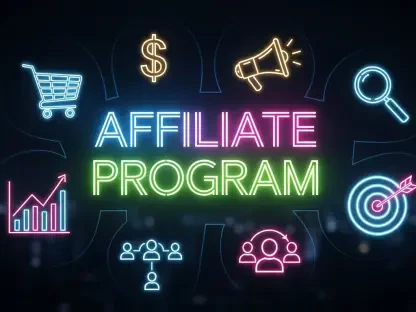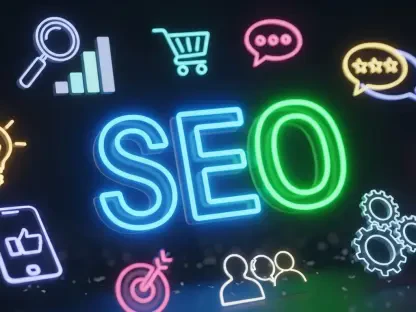In today’s rapidly evolving B2B marketing landscape, integrating advertising technology (adtech) and marketing technology (martech) is crucial for achieving full-funnel success. Anastasia Braitsik, a leading expert in SEO, content marketing, and data analytics, delves into how AI is revolutionizing the field by unifying these vital components. From breaking data silos to enhancing personalization and predictive analysis, she sheds light on the transformative role of AI in connecting adtech and martech, leading to strategic insight and effective engagement throughout the buyer’s journey.
Can you explain the convergence of adtech and martech and why it is essential for B2B marketing success?
The convergence of adtech and martech is pivotal in B2B marketing because it streamlines the entire buyer’s journey. By integrating these technologies, businesses can transition prospects seamlessly from awareness to conversion, ensuring that every touchpoint in the customer experience is efficient and impactful. This integrated approach allows for precise targeting and a more unified strategy across channels, ultimately improving the return on investment and fostering revenue growth.
How does AI help unify data across different marketing systems like CRMs, ad platforms, and web analytics?
AI acts as a central nervous system, connecting and analyzing scattered data from various marketing platforms, such as CRMs, ad services, and web analytics. It does this by ingesting and reconciling data in real-time, identifying patterns, and deriving actionable insights. This unification tackles the problem of data silos by providing a comprehensive view of customer interactions, enabling marketers to make data-driven decisions that enhance customer engagement.
What are some common issues that arise from data silos in marketing, and how does AI address these issues?
Data silos often result in inefficiencies, inconsistent customer experiences, and budget wastage, as vital information is trapped in isolated systems. AI tackles these issues by harmonizing data from diverse sources, ensuring a coherent understanding of the customer journey. This integration allows marketers to deliver more accurate and personalized campaigns, ultimately increasing conversion rates and optimizing marketing spend.
How does AI personalize marketing campaigns, and what advantages does this bring to senior-level marketers?
AI personalizes marketing campaigns by analyzing consumer behaviors and preferences across multiple touchpoints, determining the optimal content, timing, and channels for engagement. For senior-level marketers, this means enhanced strategic capabilities, as campaigns are tailored with precision, leading to higher engagement and more meaningful relationships with customers. Personalization not only drives engagement but also strengthens brand loyalty and competitive advantage.
Could you elaborate on how predictive analytics can anticipate buyer behavior to optimize lead conversion?
Predictive analytics leverage historical data combined with AI algorithms to forecast buyer behavior and intent. By understanding which leads are most likely to convert, marketers can prioritize their efforts on high-intent prospects, tailoring their outreach and content to match the buyer’s readiness to purchase. This leads to improved conversion rates, as resources are focused on leads with the highest potential, optimizing the sales pipeline and enhancing overall marketing efficiency.
What role does dynamic creative optimization play in real-time marketing, and how does AI enhance this process?
Dynamic creative optimization (DCO) involves tailoring ad content in real-time to maximize engagement and relevance. AI enhances DCO by constantly analyzing user interaction data and updating ad visuals and messaging on-the-fly to suit the audience’s current context. This adaptability ensures that ads remain relevant and engaging, increasing click-through rates and conversion potential.
How does AI facilitate contextual and account-based targeting to support ABM strategies?
AI-driven account-based marketing (ABM) strategies leverage contextual targeting to align marketing efforts with the specific needs and interests of target accounts. By analyzing firmographics and buyer behavior, AI ensures that marketing messages and advertisements are precisely targeted to resonate with key decision-makers. This level of precision enhances the effectiveness of ABM campaigns, fostering stronger relationships and driving successful outcomes with key clients.
What is the significance of maintaining omnichannel consistency in B2B marketing, and how does AI assist in achieving this?
Maintaining omnichannel consistency is crucial for delivering a seamless customer experience across all touchpoints. AI supports this by creating unified customer profiles that ensure coordinated messaging and interaction across channels, from email and social media to direct sales engagements. This consistency helps build trust and a cohesive brand experience, which are critical for customer retention and satisfaction in B2B marketing.
In what ways does AI enable marketers to derive more actionable insights and improve engagement rates?
AI enables the extraction of more actionable insights through advanced data analytics that dissect customer behavior patterns and preferences. This deeper understanding allows marketers to craft more relevant and compelling messages, improving engagement rates by ensuring that marketing efforts are aligned with the audience’s interests and needs. The ability to quickly adapt to changes in consumer behavior is invaluable for maintaining high engagement levels.
How does AI orchestrate campaigns across different channels and accurately attribute results?
AI orchestrates campaigns by monitoring performance metrics across all channels and automatically reallocating resources to the most effective platforms. It provides multitouch attribution, granting credit to every interaction a customer has, rather than relying on outdated models like last-click attribution. This holistic approach to campaign management ensures a more accurate assessment of marketing efforts, allowing for more strategic resource allocation and optimization.
What are the challenges of manual coordination in B2B journeys, and how does AI solve these challenges?
Manual coordination of B2B marketing efforts is often plagued by inefficiencies, inconsistencies, and human error, especially given the complexity and length of B2B sales cycles. AI addresses these challenges by automating and optimizing coordination across multiple touchpoints and platforms, ensuring that campaigns are consistently aligned with overarching business goals and customer expectations. This results in more efficient and effective marketing operations.
Can you explain AI’s role in multitouch attribution models and how it differs from last-click attribution?
Multitouch attribution models attribute credit to all touchpoints a customer interacts with before conversion, as opposed to last-click attribution, which credits only the final interaction. AI enhances these models by analyzing complex data sets to determine the influence of each touchpoint in the customer journey. This comprehensive view allows marketers to understand the real impact of their strategies, optimizing future efforts and budget allocations.
How does real-time campaign optimization with AI work, and what benefits does it offer to marketers?
Real-time campaign optimization allows AI to continually monitor and adjust campaigns based on performance metrics and changing market conditions. Marketers benefit from this by maximizing ROI through automatic budget shifts to higher-performing channels and strategies. This agile approach leads to cost savings, increased engagement, and faster response times to market dynamics, providing a significant competitive edge.
How does AI ensure offline conversions are tracked and factored into the overall customer journey?
AI ensures offline conversions are tracked by analyzing digital interactions and predicting their influence on offline activities. This analysis offers a complete view of the customer journey by integrating online and offline data, allowing better attribution and campaign optimization. Marketers can then align their online strategies with offline sales efforts, enhancing the overall effectiveness of their marketing initiatives.
Why is adopting AI for orchestration and attribution important for marketing teams’ focus on strategy and creativity?
Adopting AI for orchestration and attribution frees marketing teams from the minutiae of data analysis, allowing them to focus on strategic and creative tasks. With AI handling the heavy lifting of data-driven decision-making, teams can concentrate on crafting innovative campaigns that resonate with their audience, improving brand perception and impact. This shift not only boosts creativity but also enhances strategic agility and effectiveness.
How does integrating adtech and martech with AI improve visibility and ROI throughout the marketing funnel?
By integrating adtech and martech with AI, marketers gain a comprehensive view of the entire funnel, from initial awareness to final conversion. This improved visibility allows them to connect top-of-funnel brand activities with bottom-line results, optimizing resource allocation and demonstrating marketing’s impact on revenue. Enhanced visibility leads to more informed decisions, improving ROI and fostering long-term strategic success.
Could you provide an example of how AI links ad engagement data to CRM systems for better insight?
One example is the integration of LinkedIn’s ad engagement data into CRM systems, where marketing teams can track lead journeys from initial engagement to closed deals. By linking ad data directly to CRM entries, marketers gain insights into the success of their campaigns and can optimize future strategies based on real, revenue-driven results. This direct connection closes the loop between marketing actions and sales outcomes.
How does AI transform the focus from vanity metrics to revenue-based KPIs?
AI shifts the focus from superficial measures like clicks and impressions to more meaningful revenue-based KPIs by correlating marketing activities directly with financial outcomes. It enables marketers to track metrics such as pipeline value, deal size, and sales cycle length, prioritizing metrics that reflect true business impact rather than just activity levels. This transformation allows marketers to allocate resources more efficiently and justify the marketing budget with clear, ROI-driven results.
What long-term values can AI reveal in marketing campaigns that might not be immediately apparent?
AI can uncover long-term values such as brand awareness and content impact that aren’t immediately reflected in short-term metrics. For instance, it can identify how a seemingly underperforming ad actually contributed to increased brand recall or how sustained content marketing efforts correlate with reduced sales cycle times. These insights enable marketers to appreciate the broader influence of their campaigns over time, facilitating more strategic long-term planning.
How crucial is it to connect CRM, automation tools, ad platforms, and analytics for the success of AI systems in marketing?
Connecting these systems is critical because AI requires comprehensive data access to function effectively. By bridging these various platforms, marketers provide the AI system with a full scope of customer interactions and behaviors, enabling it to deliver accurate insights and recommendations. A well-integrated system allows for refined targeting, enhanced personalization, and improved ROI attribution, ultimately leading to more successful marketing outcomes.
What steps should B2B marketers take to unify data sources, and why is it important?
B2B marketers should start by auditing existing tools to identify disconnected data sources. They should employ AI-driven customer data platforms to consolidate data from ads, websites, emails, and CRM systems into a cohesive view. Unifying data sources is essential to ensure consistency across marketing efforts, allowing for more personalized and effective customer interactions based on comprehensive insights. This unification supports more strategic decision-making and optimized marketing performance.
How can predictive scoring improve pipeline velocity and win rates when combined with AI?
Predictive scoring uses AI to evaluate and rank leads based on their likelihood to convert, enabling marketers to prioritize their outreach efforts effectively. By focusing on high-scoring, ready-to-buy prospects, sales teams can accelerate pipeline velocity and improve win rates. This targeted approach ensures resources are concentrated on the most promising opportunities, enhancing sales efficiency and driving revenue growth.
Why should marketing leaders focus on AI-driven cross-channel orchestration, and what impact does this strategy have on marketing success?
Focusing on AI-driven cross-channel orchestration allows marketing leaders to synchronize strategies across all customer touchpoints, ensuring seamless experiences that align with business objectives. This coordinated approach enables optimized resource allocation and a stronger, more unified brand presence. Emphasizing cross-channel orchestration leads to higher engagement, improved customer satisfaction, and ultimately greater marketing success through efficient and effective campaigns.
What is your forecast for the adoption and evolution of AI in B2B marketing?
As AI continues to advance, its adoption in B2B marketing will undoubtedly grow, driven by its ability to enhance efficiency, personalize experiences, and provide deep strategic insights. I foresee AI becoming even more integral, not only for orchestration and attribution, but also in elevating the entire marketing ecosystem. With ongoing innovation, AI will increasingly empower marketers to anticipate trends and adapt swiftly, strengthening their capabilities in an ever-competitive space.









